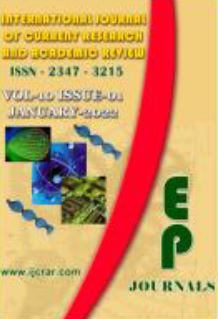Abstract Volume:10 Issue-1 Year-2022 Original Research Articles
 |
Online ISSN : 2347 - 3215 Issues : 12 per year Publisher : Excellent Publishers Email : editorijcret@gmail.com |
2Jimma University College of Agriculture and Veterinary Medicine, P.O.B. 307, Jimma, Ethiopia
Background and Objective: Ethiopia is the center of origin and diversity of Arabica coffee which serves as a driving force for the country’s economy. However, fungal pathogens especially C. kahawae induce coffee berry disease challenges coffee production widely. Hence, the objective/s/ of this study was to evaluate the reaction of local C. arabica accessions against coffee berry disease under field and laboratory conditions. Materials and Methods: CBD was assessed on a total of 100 coffee accessions (92 accessions plus 8 checks) under field condition visually (0-100% disease scale) and further evaluation was undertaken on the best performed promising accessions via attached (field) and detached berry test (lab.) conditions. Results: the result indicated significant differences (P<0.001) among treatments at both conditions. Six accessions namely G63, G65, G57, G72, G15, and G70 revealed the lowest disease severity score (<10%) at field ABT and G65, G63 and G15 showed 24-28% infection percentage in the lab DBT, hence, relatively resistant for CBD. While, four coffee accessions i.e. G50, G89, G92, and G67 showed a susceptible reaction (>25% berry infection). Here, the present study not only directed the impact of CBD rather demonstrates the role of host resistance in combating this disease. Conclusion: Therefore, future research should focus on the evaluation of these promising coffee accessions across multi-location field trials several years, diversity/identity verification of C. kahawae isolates using more other methods, and further studies on the resistance mechanism of CBD as a priority research topic for full understanding about C. arabica - C. kahawae pathosystem.
How to cite this article:
Zenebe Wubshet Hordofa, Daniel Teshome Lopisso and Weyessa Garedew Terefe. 2022. Evaluation of Gidami Coffea arabica Collections against Coffee Berry Disease (Colletotrichum kahawae), Western Ethiopia.Int.J.Curr.Res.Aca.Rev. 10(1): 81-91doi: https://doi.org/10.20546/ijcrar.2022.1001.009



Quick Navigation
- Print Article
- Full Text PDF
- How to Cite this Article
- on Google
- on Google Scholor
- Citation Alert By Google Scholar
